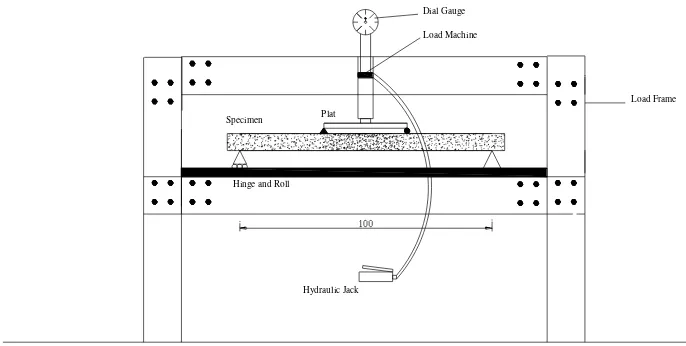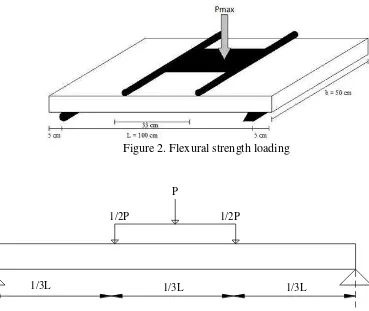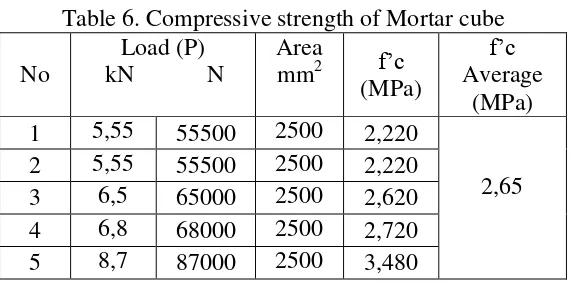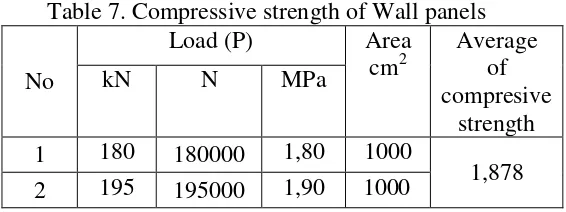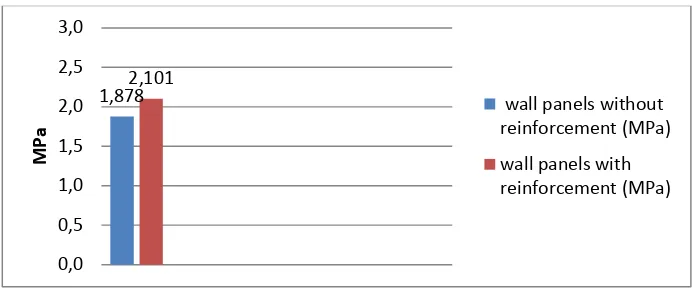WIREMESH REINFORCEMENT CONTRIBUTED FLEXURAL AND COMPRESSIVE STRENGTH ON BRICK WALL PANELS
PUBLICATION PAPER
Submitted as One of Requirement for Finished Bachelor Degree Civil Engineering of Engineering Faculty
by:
ROZZAANA ISLAMIA D100 122 004
CIVIL ENGINEERING DEPARTMENT ENGINEERING FACULTY
WIREMESH REINFORCEMENT CONTRIBUTED FLEXURAL AND COMPRESSIVE STRENGTH OF BRICK WALL PANELS
Abstract
Wall is one of the important elements of the building and serves to separate and form a space in residential buildings or storied. In the development of the world very rapidly and building construction technology advances, many new innovations are found on the walls of one of them is a precast wall panels with reinforcement.Wall panels have a high quality and provide convenience in workability and structural systems efficiently determine the construction budget, the concrete in the wall panels were replaced by bricks coated mortar to become the cheaper alternative, and required a different method, namely red brick mounted horizontally for creating a thinner wall and efficiently. The test object is created with a size of 50 cm width, 100 cm length and 10 cm height for testing compressive strength and flexural strength, the lifes of the specimen are planned up to 28 days. On specimen maintained by way of watered.Tests performed at this research is testing the compressive and flexural stress at 28 days. At the lifes of 28 day compressive stress values obtained without wiremesh reinforcement of 1,878 MPa and compressive stress with wiremesh reinforcement at 2.10 MPa, for flexural stress without reinforcement wiremesh obtained a value of 1.493 MPa and with wiremesh reinforcement of 3,800 MPa. In this case the visible increase in the compressive strength and flexural due wiremesh reinforcement.
Keywords: Wall panels, Brick, Wiremesh, Reinforcement, Compressive Strength, Flexural Strength Dinding merupakan salah satu elemen penting dari bangunan dan berfungsi untuk memisahkan dan membentuk ruang di bangunan tempat tinggal atau bertingkat. Dalam perkembangan dunia yang sangat cepat dan kemajuan teknologi konstruksi bangunan, banyak inovasi baru yang ditemukan di dinding salah satunya adalah dinding pracetak panel dengan tulangan. Dinding panel memiliki kualitas tinggi dan memberikan kemudahan dalam pengerjaan dan struktur sistem efisien menentukan anggaran konstruksi, beton di panel dinding digantikan oleh batu bata dilapisi mortar menjadi alternatif yang lebih murah, dan diperlukan metode yang berbeda, yaitu bata merah dipasang horizontal untuk menciptakan dinding tipis dan efisien. Benda uji dibuat dengan ukuran lebar 50 cm, panjang 100 cm dan tinggi 10 cm untuk pengujian kuat tekan dan kuat lentur, yang lifes dari spesimen yang direncanakan sampai dengan 28 hari. Pada spesimen dipelihara dengan cara watered.Tests dilakukan pada penelitian ini adalah pengujian tegangan tekan dan lentur pada 28 hari. Pada umur nilai tegangan tekan 28 hari diperoleh tanpa penguatan wiremesh dari 1.878 MPa dan tegangan tekan dengan tulangan wiremesh di 2.10 MPa, untuk stres lentur tanpa penguatan wiremesh diperoleh nilai dari 1,493 MPa dan dengan tulangan wiremesh dari 3.800 MPa. Dalam hal ini peningkatan terlihat dalam kuat tekan dan lentur karena tulangan wiremesh.
1.INTRODUCTION
Wall is on of the important elements of the buildings and serve to seperate form a space in building
and residence, in the development of rapid an all powerful, especially for the progress of the
construction technology. Currently many discovered new innovation about the walls, one of these
innovations is a wall panels precast trough fabrication or cast in situ with the main material is
concrete, wall panels used to alternative for conventional wall because wall panels has a high
quality and provide convenience in progress, as well as if the system very efficient in the structures
that determine the construction budget. In this case should be done in construction cost is the use of
materials or used lowest cost alternative materials.
Required methods and materials has advantages of better than already exist such as the
selection materials like the brick as alternative of concrete and the manufacture of wall panels with
brick that is placed differently is mounted horizontally to create a characteristic wall panels more
lighter, and the dimension of the wall is thinner so that from the side of the form will be more
efficient and effective.
The main types of material used in research is a brick because brick is a new alternative
in wall panels technologies, not as with concrete, brick has lighter density than concrete in general
density is 2000-2400 kg/m3. Because the brick main advantages exist on weight, so that used in
high rise project will be able to significantly reduce of its weight, which can give impact on
calculation of the foundation.
Wall panels generally used a mixture of normal concrete (water, coarse aggregate, fine
aggregate, and cement) and include the reinforcement. But in this research the materials used only
brick and mortar (water, fine aggregate, and cement) as well as the reinforcement in the form of
wiremesh, because can give easly for processing. For the problem of strength wiremesh with normal
reinforcement is a same, depend on the quality and type of used.
In this research will test the flexural and compressive strength of brick wall panels aims
to find and get the good wall panels as alternative of conventional brick wall. Expected wall panels
are commonly used for high rise buildings and can be applicated to residance for resistant by
earthquake.
On previous research by Danang Tri Wibowo (2013) concerning a review flexural strength
of wall panels using aggregate tile fragment with reinforcement welded mesh, concluded from the
test results flexural wall panels obtained flexural stress 2,9 MPa, it can be used as a substitute wall
flexural strength of review using a woven bamboo wall panels with styrofoam as alternative to
aggregate, and get the value 3,6 MPa to wall panels, the value is more than conventional wall.
2.RESEARCHMETHODS
In this research there are 5 stage that isstage one, preparation equipment and material supply
This stage is the stage where the equipment, places and provision of materials to be well prepared
in the laboratory so that later do not disrupt research done.
ThenStage two,examination of materialsBefore mixing the mixture should be made of all
materials must be tested according to the specified requirements. Materials fine aggregate, water
and cement should be tested properly before mixing the mortar mix to be created At this stage
examination is an examination specific gravity and absorption of sand, mud content of sand, fine
gradation inspection.
Stage three,mix design and making of test specimens this stage is used for design and
making mortar cube wall panels are expected to be eligible. Making the mortar cube is done by trial
error to find a mortar expected.
Next Stage four,specimen test this Stage testing samples of the specimen. Tests done is test
cube compressive strength testing, the density of mortar, mortar cube compressive strength and
flexural strength wall panel at 28 days.
The last is Stage five, analysis and discussion from the results of tests carried out in stage
four, then carried out the data analysis. The value of flexural and compresive strength drawn from
an average of 5 samples test specimen. The analysis is a discussion of the research results, which
can then be made several conclusions from this research.
Hydraulic Jack
Dial Gauge
Load Machine
Load Frame
Hinge and Roll Specimen Plat
Figure 2. Flexural strength loading
1/3L 1/3L 1/3L
1/2P
P
1/2P
Figure 3. Flexural strength loading test
5 cm 5 cm
Figure 4. Specimen
Table 1. specimen specification
Specimen Qty Dimension Testing
SM 5 (5x5x5)cm Compressive
SW1 2 (100x50x10)cm Compressive
SW2 3 (100x50x10)cm Compressive
SW1 5 (100x50x10)cm Flexural
SW2 5 (100x50x10)cm Flexural
Description : S1 = Mortar cube
WPI = Wall panels without wiremesh reinforcement
WP2 = Wall panels with wiremesh reinforcement
The formula for compressive strength is :
f’c =
Description :
f’c = maximum compressive strength of concrete (N/mm2
)
P = Maximum Load (N)
A = Area of the surface of the specimen (mm2)
The formula for felxural strength is :
MOR =
Description :
Mor = Modulus of rupture (MPa)
P = Maximum load (N)
L = Length (mm)
b = Width of specimen (mm)
h = Height of specimen (mm)
3.RESULTANDDISCUSSION
Research was conducted to obtain data that is used to discuss the formulation of the problem.
Based on the formulation of the problem, then retrieved data compressive strength and flexural
strength wall panels at 28 days. The data is used to determine whether the use of reinforcement in the
wall panels will improve the quality.
3.1 Examination of Cement
The cement used in this study is that Holcim cement type I with a size of 40 kg/sack produced by PT.
3.2 Examination of Fine aggregate
For fine aggregate testing conducted several tests such as organic matter content, mud content,
finenes modulus testing, fine aggregate gradation, specific gravity and absorption. Can be seen in
table 2:
Table 2. Fine aggregate testing
Examination Testing Result Requirement Description
Organic matter content No.3
(Orange) 1-5 Recomended by SNI 03-2816-1992
Mud Content 4,2 % < 5% Recomended by SNI 03-2816-1992
Specific Gravity of
Bulk 2,28 -
Saturated Surface Dry 3,77 -
Specific Gravity of
Apparent 2,56 -
Absorption 4,71 % < 5% Recomended by SNI 03-1970-2008
Gradation Area II Recomended by SNI 03-1968-1990
Finenes Modulus 2,88 1,5-3,8 Recomended by SNI 03-1749-1990
From the result, fine aggregate recomended for a mortar mixture.
3.3 Examination of Steel Strength
This test is done to determine how is tensile strength wiremesh reinforcement. Result of tensile
strength of wiremesh can be seen on Table 4. as follows :
Table 3. Tensile strength of wiremesh
Sample A (mm
2
) P max (N) f’c
(MPa)
Average (MPa)
1 22,8906 12077,24 527,607
548,079
2 22,8906 12850,15 561,3724
3 22,8906 12077,24 555,257
From the table above obtained f’s of wiremesh is 548,079 MPa. This value will contributed to the
strength of wall panels that can rise the strength of wall panels.
3.4 Mix Design
In this research, using a mix design with a mix design with method by trial error. This method is
experiments to obtain mixtures with pores that minimum or maximum density, this research using
water cement ratio (fas) 0,5 and compare for mortar 1:4, the proportion can be seen in table 5.
Table 4. Material of mix design
Material Design
Cement 15,125 kg/m3
Fine aggregate 60,5 kg/m3
Water 7,5 ltr
Total 83,125 kg/m3
3.5 Slump test
in this study, planned slump value of 10 cm. Slump Tests conducted to determine the level of
viscosity of a slurry, so it can be known whether the mixture of water shortages, excess water or
sufficient water. From the research can be seen th value of slump in table 6:
Table 5. Slump test
No Type of Specimen Slump value (cm)
1 Mortar Cube 10
2 Wall panels without wiremesh reinforcement
10
3 Wall panels with wiremesh reinforcement
10
From the result we get the value of slump is 10 cm.
3.6 Compressive Strength of Mortar cube
Compressive strength test of mortar cube
Compressive strength of mortar cube has been seen in table 6.
Table 6. Compressive strength of Mortar cube
No
Load (P) kN N
Area
mm2 f’c
(MPa)
f’c
Average (MPa)
1 5,55 55500 2500 2,220
2,65
2 5,55 55500 2500 2,220
3 6,5 65000 2500 2,620
4 6,8 68000 2500 2,720
5 8,7 87000 2500 3,480
From the result we get the average value of maximum compressive strength of mortar is
3.7 Compressive strength of Wall Panels without wirmenesh reinforcement
Compressive strength testing wall panels without wiremesh reinforcement can be seen in table.8.
Table 7. Compressive strength of Wall panels
No
Load (P) Area
cm2
Average of compresive
strength
kN N MPa
1 180 180000 1,80 1000
1,878
2 195 195000 1,90 1000
From the result we get the average value of maximum compressive strength of brick wall panels
without reinforcement is 1,878 MPa so this value refer to the wall panel can retain the load.3.8Panels
Wall Testing Result.
3.8. Compressive strength of Wall Panels with wiremesh reiforcement
Compressive strength testing wall panels with wiremesh reinforcement can be seen in table.8.
Table 8. Compressive strength of Wall panels
No
Load (P) Area
cm2
Average of compressive
strength
kN N MPa
1 210 210000 2,10 1000
2,101
2 220 220000 2,20 1000
3 228 228000 2,28 1000
4 242 242000 2,42 1000
5 250 250000 2,50 1000
From the table above obtained value flexural strength of wall panels is 2,101 MPa. So if this
speciment accept load more than the load above it will be directly broken.
From all the table and discovered that the average compressive strength of wall panels
without wiremesh reinforcement of 1,878 MPa and an average compressive strength of wall panels
with wiremesh reinforcement amounted to 2,101 MPa. Compressive stress increased by 11,859%
from the average compressive strength of the wall panel without percutaneous wiremesh. In this
experiment, contributing fs wiremesh give at 548,079 MPa, the comparrison of value compressive
3.9 Flexural strength of Wall Panels without wiremesh reinforcement
Flexural strength testing wall panels without wiremesh reinforcement can be seen in table.10.
Tabel 9. Flexural strength of wall panels with reinforcement wiremesh.
No b (mm) l (mm) h (mm) Flexural Strength (MPa) Average Flexural Strength (MPa)
1 500 1000 100 1,00
1,493
2 500 1000 100 1,28
3 500 1000 100 2,22
From the result we get the average value of maximum flexural strength of brick wall panels
without reinforcementis 1,493 MPa so this value refer to the wall panels can retain the load.
3.10 Flexural strength of Wall Panels with wiremesh reinforcement
Flexural strength testing wall panels without wiremesh reinforcement can be seen in table.10.
Table.10. Flexural stress of wall panels
No b (mm) l (mm) h (mm) Flexural Strength (MPa) Average Flexural Strength (MPa)
1 500 1000 100 3,20
3,80
2 500 1000 100 3,60
3 500 1000 100 4,00
4 500 1000 100 4,00
5 500 1000 100 4,20
. From the result we get the average value of maximum compressive strength of brick wall panelswith reinforcement is 3,80 MPa so this value refer to the wall panel can retain the load.
1,878 2,101
0,0 0,5 1,0 1,5 2,0 2,5 3,0 M Pa
wall panels without reinforcement (MPa)
From the all table above discovered that the average flexural strength of wall panels without
wiremesh reinforcement of 1,493 MPa and an average flexural strength of wall panels with
wiremesh reinforcement amounted to 3,800 MPa, flexural strength increased by 154,464% from the
average flexural strength of the wall panels without percutaneous wiremesh, the comparison can be
seen in graph 2 :
Graph 2 Comparison of Flexural stress of wall panels
From the graph above test results, the flexural strengthwall panels has a bending strength is not
small, making it suitable used as an alternative to a brick wall or other building materials. At the
time of testing, the panels wall when receiving the maximum load is not immediately broken, only
the arched detained by steel reinforcement which adds to the flexural strength of the wall panels.
4.CONCLUSION AND SUGGESTION
From the results of research conducted on the panels wall with wiremesh reinforcement can be
summarized as follows:
1. From the test of compressive strength mortar cube get the average value is 2,65 MPa this value
is quality of mortar so this value refer the strength of mortar can retain the load.
2. From the test results of compressive strength of wall panels without wiremesh reinforcement get
the average value is 1,878 MPa, while the wall panels with wiremesh reinforcement the average
value is 2,101 MPa, if the valus is compare obtained the increase of compressive strengthby
11,859% because wiremesh reinforcement can retain the load itself.
3. From the test results flexural strength of panels wall without wiremesh reinforcement get the
average value is 1,493 MPa, while the value of flexural strength panels wall with wiremesh
reinforcement is 3,800 MPa, if the valus is compare obtained the increase of flexural strengthby
154,464% because wiremesh reinforcement can retain the load itself.
Need for setting the flexural strength test equipment more practical again so that the test
specimen can be accomplished in a timely manner, for further research, should be added
dimensional variation wall panel to be more practical, efficient and easy in construction and
1,493 3,800 0,0 0,5 1,0 1,5 2,0 2,5 3,0 3,5 4,0 M Pa
wall panels without reinforcement (MPa)
installation and for further research, should be added variation cement water ratio (fas) in order
to get more diverse.
BIBLIOGRAPHY
ASTM C-78.Standard Test Methode for Flexural Strength of Concrete (using simple beam with third point loading).
Cahyono, Bagus. 2011. Kajian Kuat Lentur Beton Kertas (papercreate) dengan Bahan Tambah Serat Nylon. Surakarta : Universitas Negri Sebelas Maret.
Fahruding. Zaim Nur. 2013. Tinjauan Kuat Lentur Dinding Panel Beton Ringan menggunakan Campuran Styrofoam dengan Tulangan Kawat Jaring Kasa Welded Mesh. Surakarta: Universitas Muhammadiyah Surakarta.
Hartadi, Setia.2016. Tinjauan Kuat Lentur dan Kuat Tekan Dinding Panel dengan menggunakan perkuatan Diagonal Tulangan Baja. Surakarta: Universitas Muhammadiyah Surakarta.
http://www.ciput.us/2014/02/dinding-panel-precast.html, tanggal akses 12 November 2015.
http://sipil.studentjournal.ub.ac.id/index.php/jmts/article/download/238/205, diakses pada tanggal 7 Januari 2016
http://projectmedias.blogspot.co.id/2013/12/mengenal-material-besi-wiremesh.html, diakses pada tanggal 14 November 2015.
http://www.ilmusipil.com/ukuran-besi-wiremesh-m, diakses pada tanggal 15 November 2015.
http://www.rumahmaterial.com/2015/04/besi-wire-mesh-alternatif-pembesian.html,diakses pada tanggal 12 Januari 2016.
SNI 03-6825-2002. Metode Pengujia Kekuatan Tekan Mortar Semen Portland untuk Pekerjaan Sipil. Badan Standarisasi Nasional Indonesia.
SNI 15-2049-2004. Semen. Badan Standarisasi Nasional Indonesia.
Sumaryono, 2012.Dinding Panel Bertulangan Bambu dengan Bahan Pasir, Semen dan Kapur.Surakarta: Universitas Muhammadiyah Surakarta.
Tjokrodimulyo, Kardiyono.1996.Teknologi Beton. Yogyakarta: Teknik Sipil Universitas Gadjah Mada.
Tjokrodimulyo, Kardiyono.1996.Bahan Bangunan. Yogyakarta: Teknik Sipil Universitas Gadjah Mada.
